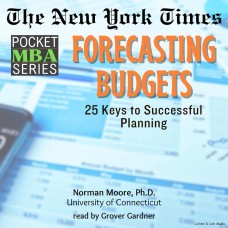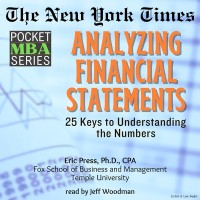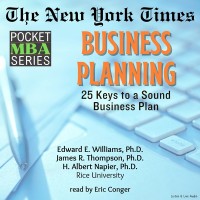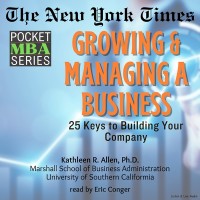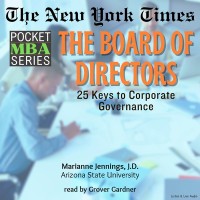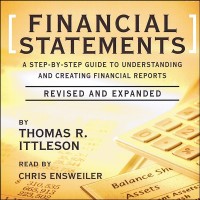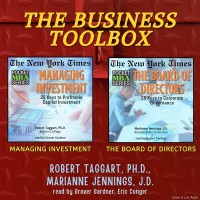Key 1. Budget blues.
Key 2. Preparing the operating budget.
Key 3. Preparing the financial budget.
Key 4. Use budgets to plan and control. Use pro forma financial statements to measure and monitor value creation.
Key 5. The budget must consider cost behavior.
Key 6. Managers must be flexible. So must their budgets.
Key 7. The budget must consider revenue behavior.
Key 8. Profits are good. Liquidity is essential for survival.
Key 9. Determining the optimal cash balance.
Key 10. Part of planning and budgeting is setting standards.
Key 11. Selecting and using the best cost allocation methods.
Key 12. Un-sheath the budget ax.
Key 13. A firm's future depends, most of all, on the capital expenditure budget.
Key 14. What should a capital budget accomplish?
Key 15. Risk is as much a part of the capital budget as return.
Key 16. The "unsophisticated" rules are more useful than you might think.
Key 17. You can't budget without forecasts.
Key 18. Time series forecasting: the past as prologue.
Key 19. Regression: a straight line to better forecasting.
Key 20. Judgmental forecasting techniques: when numbers are not enough.
Key 21. Evaluating forecasting models: through the looking glass.
Key 22. Financial models: the black boxes of planning.
Key 23. Financial modeling: spreadsheets and add-ins.
Key 24. Financial modeling: more on spreadsheets and add-ins.
Key 25. Profit-making firms can learn from nonprofit organizations.
Forecasting Budgets is part of The New York Times Pocket MBA Series, a reference series easily accessible to all businesspersons, from first-level managers to the executive suite. The 12-volume series is written by Ph.D.s who teach in the finest graduate business programs in the country, and edited by business editors from The New York Times. The structure of each volume presents an unparalleled synopsis of crucial principles of specific areas of business expertise.
---
Norman Moore, Ph.D. is an Associate Professor of Finance at the University of Connecticut, Storrs. He has taught at the graduate, MBA, graduate EMBA and undergraduate levels, and has served as President and CEO of Systronics, Inc., where he oversaw design, development and implementation of accounting/financial information applications for stand-alone and timeshare computer systems.
NARRATOR
Grover Gardner has recorded over 450 audiobooks and was named one of Audiofile Magazine's Golden Voices of 1999. He is a member of the Woolly Mammoth Theater Company, Resident Director at Everyman Theater in Baltimore and has received 5 Helen Hayes Award nominations of his work.
---
REVIEWSAV Guide
"Brings important business principles as close as your headphones."
Forecasting Budgets
Author: Norman Moore, Ph.D.
Narrator: Grover Gardner
ISBN: 9781593163716
SRP: $19.95
Length: 3:30:00
Item No: LL390
Available on the following websites: Amazon, Apple, Audible, AudioBookStore, Audiobooks, Blackstone, Catalist, Epic!, Kobo, Libro.fm, Mackin, Overdrive, StoryTel, Tumblebooks.
Related Products
Analyzing Financial Statements
Learn the 25 keys to unlocking the powerful and useful information buried in corporate financial s..
Managing Investment
Learn the 25 keys to selecting and managing outside investment, through mergers, acquisitions and ..
Organizing A Company
Learn the 25 keys to sole proprietorship, partnership, subchapter S and family ownership. Key 1. ..
Leadership & Vision
Learn the 25 keys to supervising and motivating management staff to realize your company vision, t..
Business Financing
Learn the 25 keys to find and secure the funds to start a business and keep it going-including whe..
Business Planning
Learn the 25 keys to a great business plan, including writing the company's mission, identifying m..
Going Global
Learn the 25 keys to doing business on an international scale, including foreign exchange risks and ..
Growing & Managing A Business
Learn the 25 keys in managing the growth of a business, including identifying the company's compet..
The Board of Directors
Learn the 25 keys to the role of the Board of Directors and the important points in helping to gui..
Sales & Marketing
Learn the 25 keys to build awareness of new brands and learn the secrets of forceful advertising and..
Tracking & Controlling Costs
Learn the 25 keys to understand how financial reporting and cash flow become the essential tools t..
Financial Statements
Ittelson's master work will give you that firm grasp of "the numbers" necessary for business success..
Inc. Yourself
More than two decades ago, when former Wall Street portfolio analyst Judith H. McQuown first sat dow..
The Business Toolbox: Managing Investment & The Board of Directors
In Managing Investment, you'll learn the 25 keys to finding, selecting, funding and managing outside..
.png)
